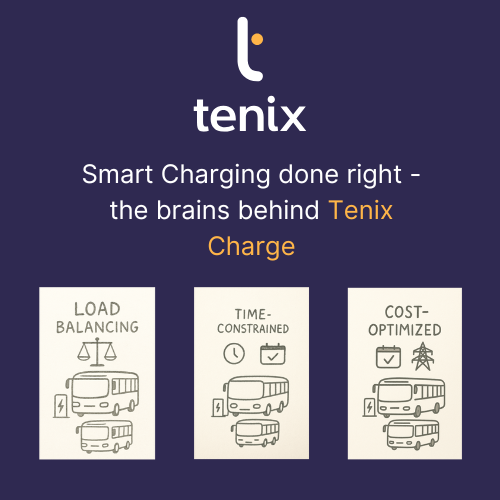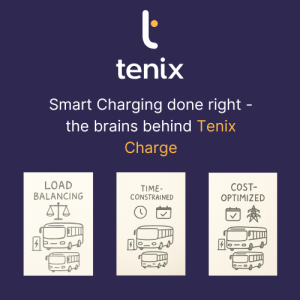Author: Grzegorz Masłowski, CTO
Managing charging for a large fleet of electric buses or trucks isn’t just about plugging in and hoping for the best. It’s a high-stakes balancing act – between vehicle readiness, energy constraints, infrastructure quirks, and cost pressures.
Even the most experienced operators face challenges like:
- Sudden power peaks or overloads that risk grid stability
- Vehicles not being charged in time for their next scheduled departure
- Higher-than-expected electricity costs due to poor timing
- Chargers or systems going offline, disrupting carefully laid plans
- A patchwork of brands and depot layouts, each with their own logic and needs
This isn’t “just charging.” This is mission-critical orchestration– and it deserves tools designed for the real world.
That’s exactly why we designed and developed Tenix Charge and its Smart Charging engine.
The Mission
At Tenix, we designed our Smart Charging system not just to simulate smart decisions in a test lab – but to deliver them, reliably, in the chaos of real-world depot operations.
That meant building charging logic that:
- Respects power constraints – whether they come from cabinet-level physical limits, dynamic grid thresholds, or cost-based caps
- Prioritises vehicle readiness – ensuring each vehicle is charged in time for its next job, route, or task, not just “filled up”
- Adapts in real-time – responding to shifting energy availability, last-minute schedule changes, and depot dynamics
- Remains operational even offline – with chargers retaining safe, autonomous behavior during temporary disconnects from Tenix Charge
- Plays along with the non-ideal reality – supporting multi-brand environments, legacy hardware, and complex depot wiring
Oh – and above all, it had to be simple and intuitive for dispatchers and depot operators to use. No PhDs required.
The Essential Modes of Tenix Smart Charging
We engineered three modes, each tailored for different operational goals. These modes are not mutually exclusive – they can coexist across chargers within the same depot.
The original design? Believe it or not, the core logic emerged in a jacuzzi – proof that solid engineering ideas can strike anywhere, as long as the thinking is sharp.
1. Load Balancing
Coordinated. Fair. Infrastructure-aware.
Unlike traditional load balancing that operates inside a single charger, Tenix shifts the intelligence to the system level – distributing available power across all active charging sesisons in the depot.
- Dynamically splits site power budget across running sessions
- Takes into account infrastructure constraints like cabinet-level limits
- No scheduling logic, no energy price planning, no individual prioritization
- Ideal for in-circulation vehicles or during operational hours with high unpredictability
Key Benefits:
- Prevents overloads by respecting real infrastructure limits
- Balances power fairly across all active sessions
- Maximizes throughput without micromanagement
- Avoids inefficient static configurations of power output, dictated by high utilization periods
2. Time-Constrained
Deadline-driven. Non-negotiable. Always ready.
When departure time is the priority, this mode makes sure vehicles are charged and ready – no excuses, no delays.
- Charging begins immediately when a vehicle is plugged in
- System ensures SoC targets are met by the scheduled departure (or preferred charging slots)
- Ignores price signals or cost optimization to guarantee readiness
Best for:
- Out-of-circulation vehicles with fixed routes, school runs, or depot-exit deadlines
- Operations where a missed departure equals a missed service
Key Benefits:
- Guarantees availability, no matter the power cost
- Simple to operate – plug in and forget
- Designed for peace of mind in time-critical scenarios
3. Cost-Optimised
Price-aware. Schedule-safe. Strategically delayed.
This mode minimises energy costs without compromising on readiness. The system shifts charging into low-tariff windows – but still ensures every vehicle is ready to roll when needed.
- Charging schedules are aligned with predicted low-cost energy periods
- Departure readiness is still fully respected
- Charging may be delayed to hit energy price-optimal slots – but only when it’s safe to do so
Best for:
- Fleets operating under tight cost constraints
- Depots with dynamic tariffs or day-ahead pricing contracts
Key Benefits:
- Cuts energy costs without dispatcher stress
- Makes price signals actionable without manual intervention
- Balances operational goals with financial discipline
The Smarts Behind the Modes
Every mode operates on a shared foundation of system-wide intelligence and operational resilience:
- Vehicle-Aware Charging – Considers real-world information: charging power constraints (charger, connector), vehicle (battery capacity), departure time, assigned route
- Depot-Wide Coordination – Power isn’t managed charger-by-charger, but holistically across Power Groups and infrastructure constraints
- Live Replanning – Continuously recalculates charging schedules as vehicles arrive, plans change, or power availability shifts
- Offline Resilience – Chargers retain local fallback behavior and limits when disconnected from the backend – no chaos during connection hiccups
- Vendor Agnostic – Works across mixed-brand environments via OCPP 1.6j, and built to embrace 2.x where supported
- Manual Boosting – When something unplanned happens – vehicle swap, route change, new departure – you can override the plan with one click and reprioritise charging on the spot
Designed for Flexibility
We structured our backend to understand depots not just as a flat list of chargers, but as interconnected Power Groups and Power Consumers:
- Power Groups = cabinets or logical power zones
- Consumers/Producers = building load, PV (PhotoVoltaic panels), ESS (Energy Storage Systems)
This model lets us adapt to how a depot is wired – not just how a charger is labeled.
Why Tenix Smart Charging is the right choice?
The future of fleet electrification isn’t just about putting plugs in the ground. It’s about making charging:
- Predictable
- Affordable
- Resilient
At Tenix, I didn’t just design the charging modes – I designed them to solve real operator pain, with a platform that’s flexible, battle-tested, and ready for scale.
Let’s just say, we’ve done the thinking – so you don’t blow a fuse. Literally.
Want to see it in action? Get in touch. Or better – ask your charger if it’s Tenix-smart yet.



